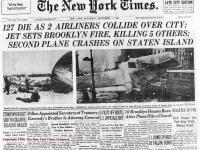Brooklyn Plane Crash

BROOKE GLADSTONE: On the morning of December 16th, 1960, two airplanes, one an old TWA plane bound for La Guardia Airport, the other a state-of-the-art United Turbojet headed to Idlewild, collided in the fog over New York City. The flaming wreckage from one of the planes landed in the so-called “transitional” neighborhood of Park Slope, Brooklyn, destroying several buildings, including the Pillar of Fire Church.
MALE CORRESPONDENT: The church is completely demolished. Several other buildings are completely afire, and very heavy smoke is blanketing the entire area.
BROOKE GLADSTONE: The New York Times ran a triple banner headline and described what was then the worst air disaster in American history - more than 130 dead, both in the air and on the ground. Fifty years later, The New York Times is once again covering the story. A handful of staff members are walking the streets, literally, re-reporting the events of that day. Overseeing the project is Wendell Jamieson, deputy Metro editor for Nytimes.com. He says disaster coverage has come a long way. Wendell, welcome to On the Media.
WENDELL JAMIESON: Thanks for having me.
BROOKE GLADSTONE: So let's talk first about the people who died that day. What sort of details were published in the paper?
WENDELL JAMIESON: People on that plane included businessmen, college students, a little boy named Stephen Baltz who was the only survivor. And the newspapers that covered the disaster listed all their names, and in some cases explained why they were on the plane, but there was no sense of who these people were. Today, if something like this would happen, at The New York Times or at any of the newspapers I've worked for, you'd really strive to do a portrait of these people’s lives. What we did in the case of Stephen Baltz, the survivor, was really report out his life in great, great detail, not just why he was on the plane or what happened to him after he was thrown from the plane, but his life making model airplanes at home and being in the Boy Scouts and going camping with his family.
BROOKE GLADSTONE: Now, Stephen didn't live long after that crash.
WENDELL JAMIESON: That's right. He lived until the next morning. And the whole city, and perhaps the whole country, kind of watched him very closely. He was the one little bit of good news from this horrible story. And so for a lot of people it was a real crushing second tragedy when he died the next day.
BROOKE GLADSTONE: Why do you think it’s de rigueur now in journalism to sketch the biographies of people who die in major disasters? Did it start with The Times, with 9/11 and the Portraits of Grief, which were portraits of the people who died in the Towers? And, and you were part of that.
WENDELL JAMIESON: I was. I was the editor of that. It didn't start with that, but that might be one of the largest examples of this form. Every day we put in the names of someone who died in Afghanistan or Iraq, and often the people who die then become the focus of larger feature stories. It’s a big challenge. But I just think it’s important to do because otherwise it’s just a bunch of numbers, and it’s very hard to really experience what has been lost here, if you don't know these people.
BROOKE GLADSTONE: So how are you doing that for a 50-year-old tragedy?
WENDELL JAMIESON: Well, in the case of Stephen, who’s the one we really focused on, David Dunlap, a real premier writer at The New York Times, spent many weeks getting to know his family. Stephen’s younger brother William has never really spoken of this; he’s still quite haunted by it. But in the end, he agreed to be interviewed just by email by David. And his response turned out to be more than 3,000 words long, and is an absolutely beautiful essay about his little brother and about that time in America and in – growing up in Illinois. I run a blog called City Room with Andy Newman, who’s the bureau chief, and we have no limitations of space as one would in the newspaper, so we're just going to run the whole essay, 3,000 words. You really walk away knowing this kid as a living, breathing, great little boy and not a tragic burned figure.
BROOKE GLADSTONE: Full disclosure: I've lived in Park Slope since 1995, and even briefly on the very corner of Sterling and Seventh Avenue where the, the wreckage fell. It’s kind of interesting. You discovered from going back over the old coverage that there was a coded description of that neighborhood back in 1960.
WENDELL JAMIESON: I, by the way, moved to Park Slope with my parents in 1969 and lived there until I went to college in the early '80s, and I lived on St. John’s Place around the corner and was also always fascinated by this. And, yes, the newspapers called it a neighborhood “in transition.” You can't see me, but I'm making that little quotation mark with my fingers. It was a rough neighborhood. And Emily Rueb, one of our writers, did a story looking at Park Slope in 1960 before the plane came down, and I think it would really surprise many people who live there now. It’s really a very beautiful and very upscale neighborhood.
BROOKE GLADSTONE: But it was featured in a film in the '70s, a film called The Landlord, as the quintessential New York slum.
WENDELL JAMIESON: Yes, I've seen that, and it was a rough neighborhood. And Emily found stories about a shop owner, owner of a florist, who kept a bottle of lye under the counter to throw in the face of robbers who came in. And people described houses on St. John’s Place as looking like a bomb had gone off. You know, this was before the plane came down. There was a lot of white flight to the suburbs. Banks would not give mortgages to people who wanted to live there, and also real estate agents who wanted to buy buildings and chop them up into rooming houses would try and sort of scare the residents with sort of racially coded discussions. You know, oh, this neighborhood’s really getting worse. You better sell now. But nobody really explored that day what this neighborhood was going through, so we sort of re-reported that world. And you'd learn more from Emily’s story than – about Park Slope then than you would of any of the stories at the time.
BROOKE GLADSTONE: Do you think today we would have similar kinds of teachable moments about neighborhoods that hosted disasters?
WENDELL JAMIESON: Absolutely. Several years ago there was a terrible fire in the Bronx and ten children were killed. I helped run that coverage on the Metro section of The Times, and we really looked at this community. We looked at the type of housing stock that’s there and how some of it is not inspected properly and let this fire happen. So we used this disaster as a way to show the city this whole world. And that was great journalism to be part of, and you didn't really see that in the Park Slope coverage at the time. Another fascinating thing is we have some radio from then that talks about the plane crash, live, and none of the reporters say what neighborhood it is. They just say - we're in Brooklyn:
[CLIP]:
MALE CORRESPONDENT: We're talking to you from the scene of the [BEEP] plane crash in Brooklyn, at the corner of Seventh Avenue and Sterling Place, or, or at least 200 feet from that corner.
[END CLIP]
WENDELL JAMIESON: They don't know what neighborhood it is. They've never been there. They got there, they looked at the street sign. And in - even in the newspapers it does mention Park Slope, but only fleeting.
BROOKE GLADSTONE: So we talked about changes in the way we report the “who” of disasters and also the “where.” Let's talk about now the most stark difference between then and now, which is the ”why.”
WENDELL JAMIESON: Absolutely. It’s fascinating to read the descriptions of why these two planes came down. The United plane was a DC-8 jet headed to Idlewild. The Lockheed Constellation was a TWA plane. It was going to La Guardia.
BROOKE GLADSTONE: Both airports were in Queens. The airport then called Idlewild is now called Kennedy Airport.
WENDELL JAMIESON: That’s correct. You know, the newspapers at the time that I've seen didn't really try and find out themselves why this had happened. They accepted this report from the government: The jet overshot its holding pattern and one of its transponders was out, so it didn't know where it was. Oh, well. You almost have this sense of reading it, you know, this stuff happens with those crazy things flying around up in the sky. Nobody stopped and said, wait a minute, how could a plane so easily overshoot its holding pattern. And Patrick McGeehan, who is a reporter at The Times, who did the story about this aspect of it for our series, learned that at the time there were no speed limits on jet planes. Jet passenger planes were new. He was going 600 miles an hour over New York City. So when he overshot his holding pattern, before he even knew it, he had overshot it by 12 miles. I think today, rather than wait for the government to tell us what had happened and just accept that as the final word and move on, you know, we dig very hard to figure out, well, are these rules even appropriate, do we need to do more? And indeed, in time, this crash did lead to all sorts of rules about speed flying over urban areas.
BROOKE GLADSTONE: You’re publishing some of these stories in the actual paper and all of them on the City Room blog. Why devote so many resources to something that happened 50 years ago? Did you have a conversation with your bosses about this?
WENDELL JAMIESON: I told Joe Sexton, the Metro editor, what I wanted to do. He said, great, sounds, terrific. I will admit that some of the reporters had become so passionate about this project that it got bigger than I had initially planned. Emily Reub, our producer, has created all of this multimedia stuff, including audio from that time and interviews with people who remember it. And, you know, just today Andy Newman did a great story walking around Park Slope, looking at the signs of the crash that still linger. And it’s a wonderful story because it begins describing, you know, there’s a cornice missing from one apartment building because the plane’s wing hit that building, and there’s a modern building on one corner because the brownstone that was there 50 years ago burned to the ground. And these are the sort of things you would expect. But Andy walks you down Sterling Place and eventually takes you into the backyard of a house where a guy has a huge piece of the jet still sitting there that no one ever collected. It’s really amazing.
BROOKE GLADSTONE: How long before The New York Times of 1960 moved on from this story?
WENDELL JAMIESON: Oh, that’s an interesting question. Literally, the next day, I believe, there was a fire in a aircraft carrier at the Brooklyn Navy Yard in which 49 people were killed, another huge story, and our plane crash disappears from coverage, not only in The Times but in The Daily News and The Herald Tribune and The World Telegram and other papers I've looked at. It’s gone. A week later the report comes out, this is what we think happened. They did that story. Maybe six months later, the bigger report from the Civilian Aeronautical Board came out. They reported that story. But, boy, did it fade fast. If that were to happen today, God forbid, I could guarantee you weeks of coverage in The Times and, and the other local newspapers.
BROOKE GLADSTONE: Any other decades-old news planned for the paper?
WENDELL JAMIESON: Oh no, I'm taking a break from 1960 New York when we're done with this, and I'm coming back to the present.
BROOKE GLADSTONE: I hear some really cool things happened in 1896. [LAUGHS]
WENDELL JAMIESON: [LAUGHS] Yes, well, maybe we'll do 1896 Day on the City Room blog.
[BROOKE LAUGHS] And we'll write as they used to then and have only engravings and Gothic type on all the stories.
BROOKE GLADSTONE: Wendell, thank you very much.
WENDELL JAMIESON: Thank you so much for having me.
BROOKE GLADSTONE: Wendell Jamieson is deputy Metro editor for Nytimes.com. He oversees the City Room blog, where all of the news reporting about the 1960 plane crash in Park Slope can be found.
[CLIP]:
MALE CORRESPONDENT: [BEEP] The police and fire department are having a difficult time in keeping crowds away from the scene, and even the press, because of the extent of the damage, is held at some distance from the scene, so we cannot give you an accurate report.
[MUSIC/MUSIC UP AND UNDER]
BOB GARFIELD: That's it for this week's show. On the Media was produced by Jamie York, Mike Vuolo, Nazanin Rafsanjani, Alex Goldman, P.J. Vogt and Sarah Abdurrahman, with help from Nerida Brownlee, and edited – by Brooke. Our technical director is Jennifer Munson. Our engineers this week were Dylan Keefe and Rob Granniss.
BROOKE GLADSTONE: Andy Lanset is WNYC’s archivist. Katya Rogers is our senior producer. Ellen Horne is WNYC’s senior director of national programs, and the wind beneath our wings. Bassist/composer Ben Allison wrote our theme. You can listen to the program and find transcripts at Onthemedia.org. You can also post comments there. You can find us on Facebook or follow us on Twitter, and you can email us at Onthemedia@wnyc.org. On the Media is produced by WNYC and distributed by NPR. I'm Brooke Gladstone.
BOB GARFIELD: And I'm Bob Garfield.
[MUSIC OUT] [FUNDING CREDITS] *** [END] ***

